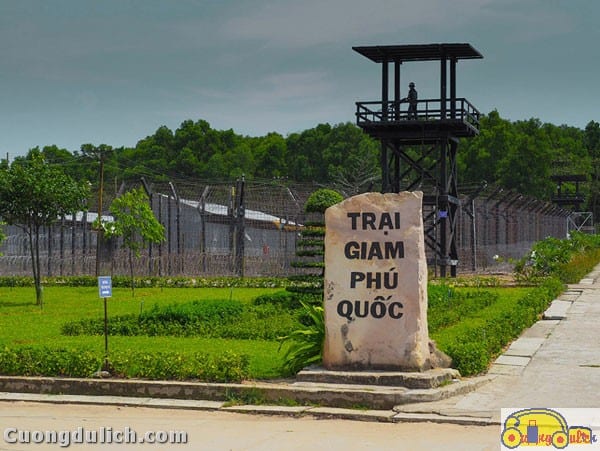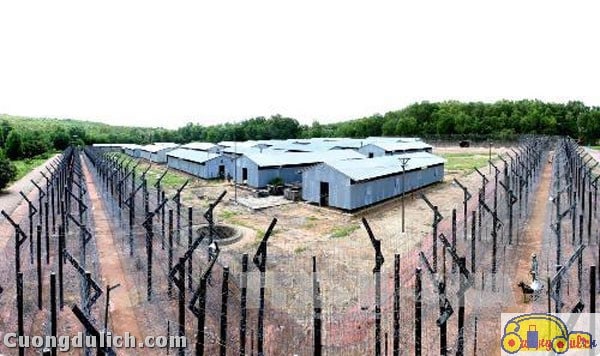Cuồng has just returned from a trip to Phu Quoc, where he visited many places and saw many sights, but none left an impression and emotions like the most famous historical landmark of this tourist destination: Phu Quoc Prison. Phu Quoc Prison is a place that evokes painful memories of a violent period in history, where thousands of political prisoners, mostly Communists, were arrested and imprisoned by the French and American authorities. This place witnessed numerous horrific and inhumane torture methods, causing former prisoners to suffer physical and psychological trauma for life. The wax statues depicting the haunting torture scenes at Phu Quoc Prison are chilling to behold. Join Cuồng in exploring the “24 brutal torture methods at Phu Quoc Prison.”
Phu Quoc Prison Tourist Destination
The first thing that caught Cuồng’s eye was the row of numbered prison cells. Each cell is 5 meters wide and 20 meters long, where the prisoners of Phu Quoc Prison were held. Looking at the emaciated prisoners, one can see how notorious the guards treated these Communist soldiers.
Cell block at Phu Quoc Prison
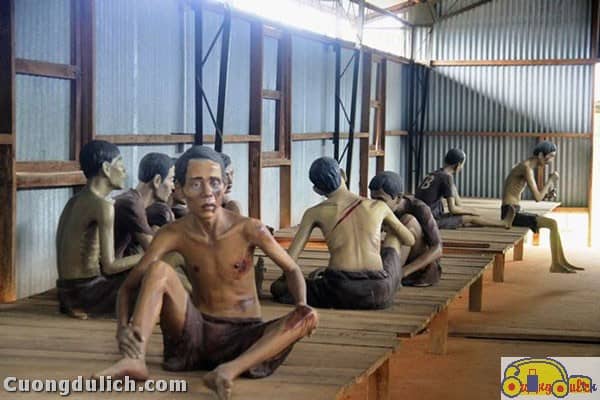
Prisoners being held and tortured at Phu Quoc Prison
In addition to the main detention area, there are also strange rows of cages for keeping animals. When asked by the tour guide at the Phu Quoc Prison tourist site, I learned that they are called “tiger cages,” another brutal tool for torturing prisoners. These cages are made of barbed wire, with just enough space for prisoners to lie down or sit. The guards came up with cruel methods of torture, from pouring cold water on prisoners at night, to pouring salt water or lighting fires near the cages on hot days. Many prisoners have died from this form of torture.
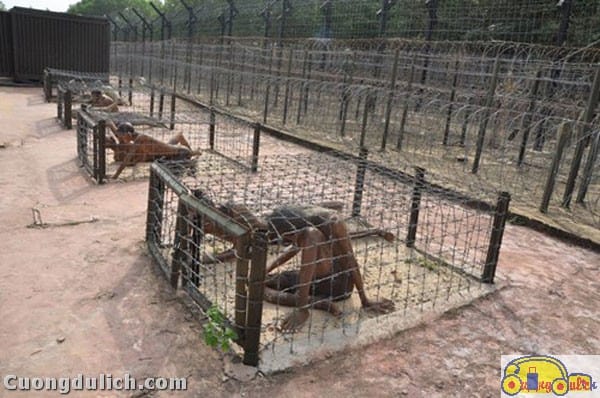
Torture methods – tiger cage
24 torture methods at Phu Quoc prison
The deeper you delve, the more horrifying the torture methods become. A total of 24 terrifying torture techniques have been applied by the Phu Quoc prison guards to break the will of Communist prisoners, as well as to extract information, with methods of physical and mental torture that seem to only exist in hell:
- Breaking the bones of the ankles and kneecaps;
- Using wooden planks and nails to tighten until the victim’s chest breaks;
- Using pliers to pull out fingernails and toenails;
- Using a torch to burn the soles of the feet;
- Using a chisel to break each tooth;
- Gouging eyes, using high-voltage lights near the eyes until they burst;
- Dropping prisoners into boiling water;
- Nailing prisoners of all sizes on their bodies, small ones through the fingers, large ones into the armpits, knees, the largest ones into the skull to kill the prisoners.
- Dousing with gasoline and burning the mouths of uncooperative prisoners
- Firing mortar shells into the prisoner camp
- Cutting the “private parts” of prisoners, inserting live leeches, then sewing them back up;
- Heating red iron rods and continuously piercing through the calves;
- Cutting open the abdomen, extracting the liver;
- ….
Tooth extraction is considered one of the lighter torture methods among the 24 techniques devised to torture prisoners at Phu Quoc prison. A small stick is placed on the prisoner’s tooth, then a hammer is struck on the stick. To extract an upper tooth, strike downwards, to extract a lower tooth, strike upwards. Once the tooth falls out, the prisoner must immediately swallow the blood, some are even forced to swallow the tooth down to the stomach. When seeing that scene, one involuntarily raises their hand to check if their teeth are still there. Anyone who has had a tooth pulled surely remembers how painful it was, yet the prisoners at Phu Quoc prison have to endure having multiple teeth extracted at once, two, three, even up to ten teeth at a time, surely experiencing pain a thousand times over.
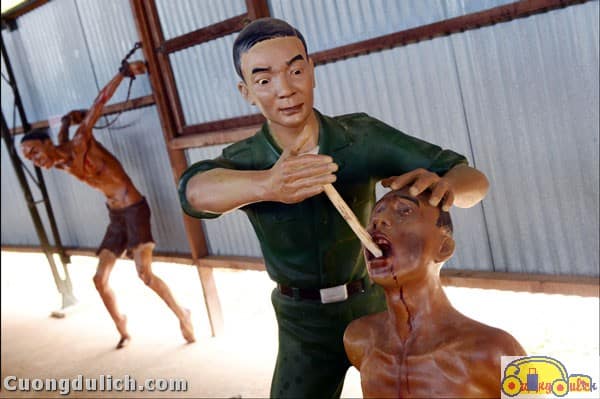
Torture method – tooth extraction
Even more horrifying is the torture method using high-voltage lights. Prisoners are made to lie on a chair, then a high-voltage light is placed directly over their eyes. The guards at Phu Quoc prison force the prisoners to keep their eyes wide open and shine the light into them for a long time, until their eyes become sore and may even burst.
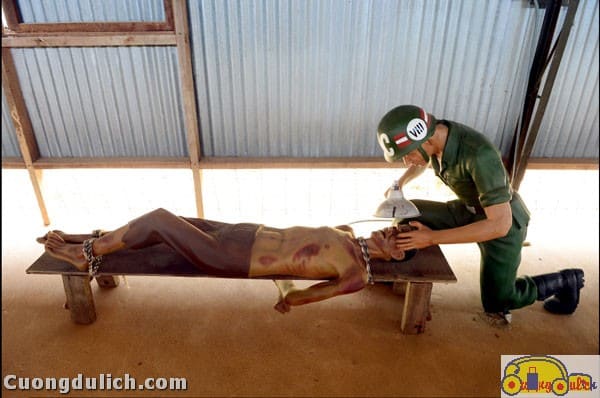
Torture method – High-pressure light shining into the eyes
Moreover, there are prisoners who are put into barrels filled with water. A guard at Phu Quoc prison presses the prisoner’s head down into the water-filled barrel, while another person uses a hammer to hit the barrel hard, causing many prisoners to have their ears burst, spewing water until they die. If someone has ever shouted into your ear, you must have felt a severe headache, right? Imagine that pain multiplied a thousand times, and you will be able to imagine what the prisoners have to endure.
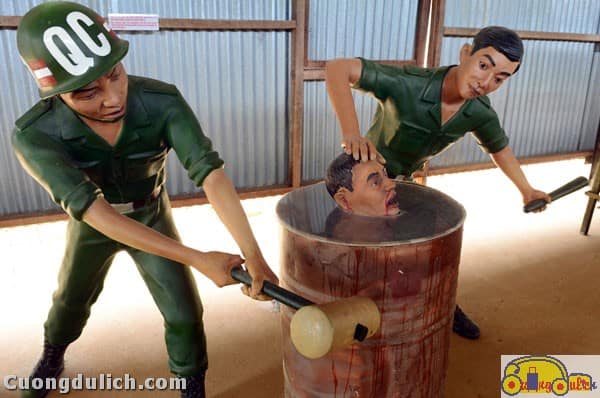
Torture method – Barrel drumming
Another gruesome torture method, seemingly only from the Middle Ages, is boiling prisoners alive. The prison guards at Phu Quoc prison put the prisoners in a sack, then put them in a pot of boiling water. If any of us have ever been scalded by boiling water, we know how incredibly painful and stinging the burn becomes, even if it’s just a very small part of the body. I cannot imagine how intense that pain would be when the entire body is submerged in boiling water. Despite the excruciating burns, the prisoners still resolutely refuse to show pain or cry out in agony, forced to endure the torture blows of the guards.
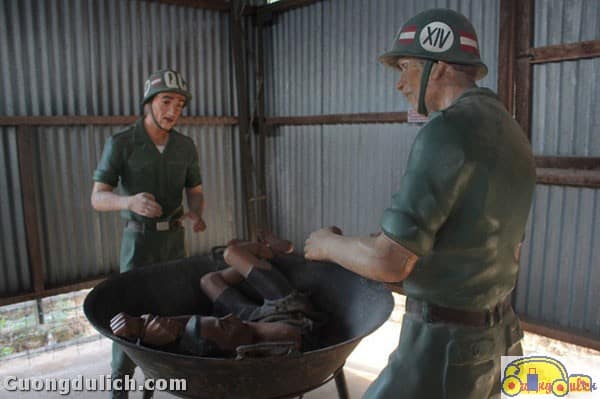
Torture Methods – Boiling People in Hot Water
The author of brutal torture methods at Phu Quoc Prison
The author is the chief warden of Phu Quoc Prison: Bay Nhu. Bay Nhu was born in 1926 in Cao Lanh, Sa Dec. In 1946, he joined the encouragement team for the People’s Army of Vietnam, and later the Republic of Vietnam Armed Forces. In 1967, he was transferred to Phu Quoc Island when Phu Quoc Prison was established and promoted to the chief warden of the prison. He came up with up to 24 different torture methods, most of which left physical and mental scars that could not be healed.
After the war, despite committing unforgivable crimes, Bay Nhu only had to undergo labor re-education from 1975 to 1979 and was released without punishment from the Vietnamese government. Haunted by his past sins, Bay Nhu lived in seclusion, followed a vegetarian diet, practiced Buddhism, and sought forgiveness.
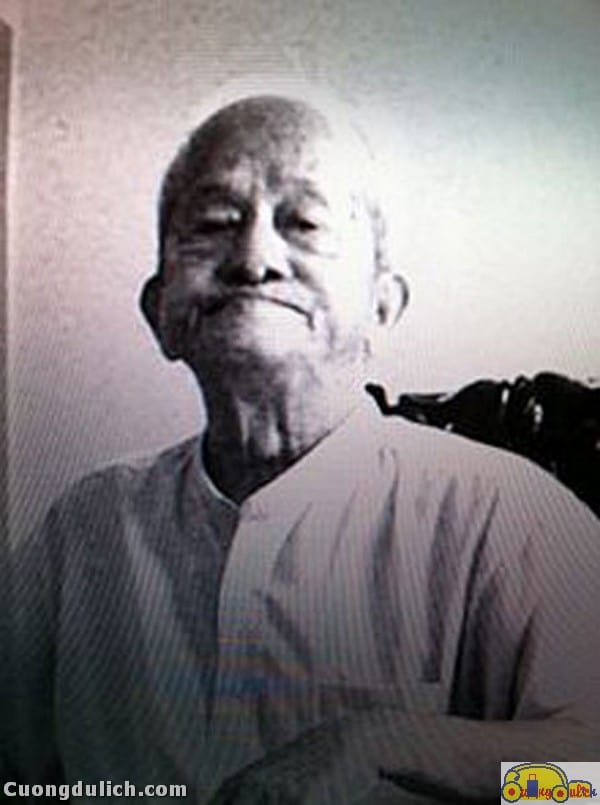
Seven Nhu, the notorious prison warden at Phu Quoc prison
Some witnesses at Phu Quoc prison recount…
Savage and brutal as it was, hearing the surviving witnesses from Phu Quoc prison recount their experiences was even more horrifying. One of those extraordinary individuals was Mr. Vu Minh Tang. As the deputy secretary of the prison’s party cell, he encouraged his fellow inmates to study politics, motivated them to escape, and as a result, he was subjected to Seven Nhu’s and his accomplices’ cruel and ruthless torture, as well as to serve as a warning to other prisoners. He recounted that the “tiger cages” in the solitary confinement cells were only 24 square meters wide, yet they often crammed up to 300 people inside. The ventilation holes were only as small as a person’s wrist, so the air inside the cages was always suffocating. Every day, at least 20 people died, sometimes up to 80. Additionally, he had his teeth drilled by Seven Nhu himself. Nine times his teeth were drilled, with nine teeth being forced down his throat along with a lot of blood. He had to search through his own feces to find those 9 teeth, but only found 8. The ninth tooth was too sharp, it pierced his stomach and remained there until now. He sewed the 8 teeth onto his belt to keep them during the 600 days of captivity until he was released. Afterwards, he donated those 8 teeth to a museum for preservation.
Years after the war ended, Mr. Tang finally had the opportunity to undergo a health check-up. He had an R15 bullet lodged in his eye socket, a slight impact could permanently blind him. He also had 2 broken ribs, 4 cracked vertebrae, a perforated stomach, suffered from joint disease all year round.
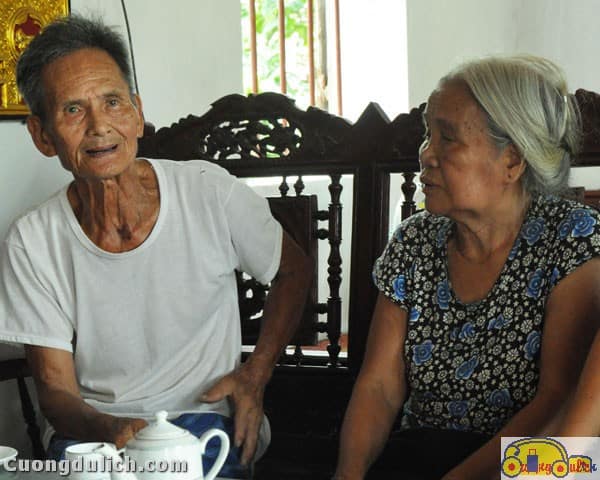
Mr. Vu Minh Tang – one of the former prisoners who survived Phu Quoc prison
Despite the brutal torture methods devised by the prison authorities, the prisoners at Phu Quoc prison remained resilient, choosing death over betrayal and refusing to give in, determined not to betray their homeland. Finally, the Paris Peace Accords of 1973 arrived, and the surviving Phu Quoc prisoners were released, closing a chapter in Vietnam’s history filled with pain, brutality, and cruelty.
If you visit the tourist destination of Phu Quoc, do not miss Phu Quoc Prison. As I stepped out of Phu Quoc Prison, I was still immersed in thoughts and reflections on what I had seen and heard. This tourist spot in Phu Quoc is evidence of the fierceness and cruelty of war, the high price paid in bones, blood, and lives that our ancestors were willing to sacrifice for future generations, and a reminder of the value of freedom and peace.









